 A selection of paintings, 1950-52. A selection of paintings, 1950-52.
Medium is indicated for each work. However,
because a number of these paintings are lost or destroyed, sizes are
approximate.
Click here for a directory to all 1950's paintings
Scroll down for the paintings, click the image
for a larger view.
|
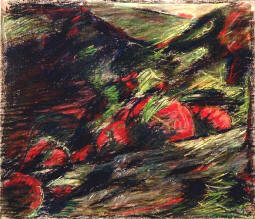 Hesperian Fruit, 1951. Hesperian Fruit, 1951.
Pastel on paper, approx 18 x 20 in.
I
married Jean Fisette in January of 1950 and by July it was clear we
would have our first child sometime in March of 1951. So, I could not
be an artist, I had to find a reliable job. My father gave us the
money to live on while I got a teaching credential, and I worked in a
book store during semester breaks. I bought some soft pastels from
the bookstore’s art supply department, and began to paint with
pastels… this painting is among the first. It was also the first
where I tried to find a symbol—an emblem, a sign, a talisman—for woman
as the origin of immortality. This first time, it was to be
pomegranates would be the symbol (because in those days when you
bought pomegranates at the store they were often cracked and the
shining seeds shone like jewels)—only thing was, I didn’t have any
pomegranates to look at so these look more like tomatoes.
And, I got
that cad red light sun at the top of the painting—both its color and its
shape—from Franz Marc’s Mountain Landscape at SFMOMA. |
|
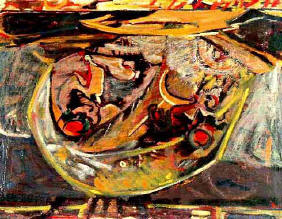 Homage to Kandinsky, 1950-51. Homage to Kandinsky, 1950-51.
Oil on canvas, approx. 20 x 30 in.
Kandinsky was very
important to me then and now (beginning when I bought the 1946
Guggenheim Museum edition of his
On the Spiritual in Art in 1947). Sometime in 1950-51 I made
this painting as an Homage to Kandinsky. I did not
think of the painting as an homage to Kandinsky when I made it, but
only as a painting I liked and that somehow reminded me of him. I
never made another painting like it, though I have kept at making
luminous horizons ever since. The painting’s survival after I made it
indicates more that I never thought about the painting at all than it
does I thought it was a masterpiece…it wasn’t. But, when I began to
go through old work in preparation for my 2003 Oakland Museum Retrospective and
found the painting where it had been left forgotten for most of half a
century, I kept it and photographed it as a messenger from times that
will not return
|
|
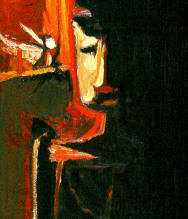 Apocalyptic Doings, 1950. Apocalyptic Doings, 1950.
Oil on canvas, approx. 30 x 24 in.
I remember
few of my paintings from the early 1950's, and even fewer
remain in fact--and of all but two, the factual remainders are only
slides.. Of the slides there remains Apocalyptic Doings (what a lame
title). We were into thick paint in those days, and our thick paint
wrinkled like shriveled orange peel. The apocalypse was a
self-portrait of my face and chest -- or was it my -- what do you call
the person who inducts you into the priesthood, into the knighthood
and fellowship of the Holy Grail? And in the distance, he stands
before me with blazing white wings as I kneel and he touches my
shoulder...
Where do
these images come from? Was (am) I the only one who finds lying on
the path of life such pictures of a high -- and megalomaniacal -- destiny? I
look around me at what young artists make today, and I am sure that
they are as I was, in search of a purpose for hope and a release from
pain.
I joined
Artists Equity... it would do for artists what Actors Equity did for
actors, what the Musicians Union did for musicians. Artists Equity's
big project was a slide registry of members; we each had two slides.
My only record of Apocalyptic Doings is the slide the Artist
Equity photographer made that I still have, and my memory for ever of
the big night in the SMOMA when all the slides were shown. The woman
in charge read the artist and title of each. "Fred Martin,
Apocalyptic Doings," she said and there large on the screen was my
knighthood by the blazing angel of the apocalypse. No one else saw or
knew what I saw and knew. I felt only a lot like a fool.
|
|
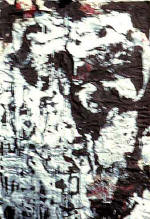 Untitled,
Spring 1950. Untitled,
Spring 1950.
Collage of tempera on newsprint, approx 24 x 18 in.
Jean and I were only a few months married, living in a rented
room with a gas hotplate on Benvenue Avenue in Berkeley. I no
longer lived at home so could not paint there, and had been rejected
for the UC Berkeley Art Department MA Program so could no longer paint
there. We had to have a studio, and Sam Francis found one for himself
and us--the top floor of a long abandoned dairy south of campus.
We worked there for several months, Jean making
a
very large oil painting of an old ferry boat, Sam making I don't
know what (I never saw him work there), and me making collage work in
poster paint (nowadays we call it tempera) and newspapers.
This is one of my paintings from then, a survivor now only in a very
underexposed and out of focus slide. I remember the painting
mostly because I had submitted it to the Drawing, Watercolor and Print
Annual Exhibition at the SFMOMA and been rejected--not because it was
a painting (it's black and white on paper isn't it? What more do
you want?) but because the jury thought it--and, of course, It was
Me--was no damned good.
I remember the opening, walking through the crowded gallery and seeing
Ernest Briggs and his drawing that was not unlike mine. Briggs
was then a super-hotshot returned vet student at SFAI, and he was in
and I was out. I was devastated.
I remember the opening and Briggs and his drawing; but what I remember
most was how afterward I drove Jean and me through the old, old, dark,
dark warehouse/wharf districts of San Francisco... those places, those
darknesses, were me. Now Briggs is gone and so are the
warehouses, Briggs to I know not where and the warehouses to high rise
condominiums and the world headquarters of Gap clothes. In 1950,
if I wanted to get at the deepest roots of ambition and despair,
apocalypse and transcendence, this was a place. Now, other kinds
of people find other purposes there.
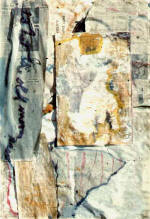 Moonlight,
Spring 1950. Moonlight,
Spring 1950.
Collage of tempera on newsprint, approx 24 x 18 in.
We were still living on Benevenue and painting in the old
dairy. There was a street named Forest near our leading
up toward a grove of Eucalyptus. One night Jean and I were
walking up the street. It was full moon. I saw the moon
through the Eucalyptus. It was beautiful and terrifying. I
made this. Perhaps the most powerful--and certainly
the most important in my memory--of the works I made in the old dairy
survives neither as slide nor in fact. It was a
construction--again, called "drawing"--Reflections on Sin, Pain, Hope
and the True Way. It was destroyed a few months after it was
made... did not, in fact, survive our moving out of the old dairy
because Sam decided to take his GI Bill and study in Paris.
I had begun the habit of writing as a way of saying and
understanding the situation in my soul and its condition of "Sin,
Pain, Hope [and hunger for] the True Way"--a phrase I had picked
up from Kafka. I had found in the back of the dairy a large,
compartmented crate for holding the big cans of milk as it comes from
the milking shed and before it is bottled. I made a construction by
covering the crate inside and out with old newspapers and then
painting them white with abstract calligraphy in black. I called it
Sin, Pain, Hope and the True Way, and entered it into the San
Francisco Art Association Annual Exhibition of Drawings and
Watercolors at the San Francisco Museum of Modern Art. Although such
objects were then most uncommon (especially as "drawings"), it was
accepted into the exhibition. The critic for the Oakland Tribune
concluded a review of the show with "and then there rose before me
something called Sin, Pain Hope and the True Way. I ran for the
way out." |
|
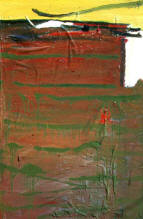 Oceanic,
Summer 1950. Oceanic,
Summer 1950.
Oil on canvas with paper collage, approx. 72 x 48 in.
One
painting that summer of 1950 I thought of as "Oceanic" in scale. I
had followed in my musical tastes the development of 19th-century
German classical music out from Mahler, both back to Bruckner and
forward to Schoenberg, and in the vastness of Bruckner's sound -- what
I think of now (I have not listened for 40 years) as his "oceanic"
chords, felt I found someplace to find peace... that is to say,
somehow an expansion beyond my perpetual straight-jacket of sexual
guilt. So, anyway, I made in the Studio Gallery days of the spring of
1950 a big "oceanic" painting. Much larger than
the Oceanic I
made three years later at Maxwell, and not ocean blue as in the
painting at Maxwell, but sunset oranges and browns and reds.
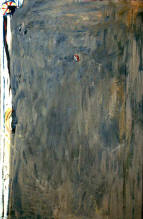 TSaint,
Summer 1950 TSaint,
Summer 1950
Oil on canvas, approx. 72 x 48 in.
The
other big painting that summer was a Saint, an archbishop or at
least some kind of holy figure... an enormous brown-blue textured
plane like a monk's robe, and holding a staff marked at the top with
the symbol of... what? Nothing, just a mark. (David Park: "If you
can't figure out what to do, decide which part is best and paint out
the rest.) The monk's robe was what the rest had been; the symbol was
what had been the only part I liked. And it was small.
|
|
 Mount Tamalpais I, 1950 Mount Tamalpais I, 1950
Oil on canvas, approx. 36 x 48 in.
There
was another painting that summer, the memory of Jean's and my hiking
day on Mount Tamalpais. It was before we had the car, must have been
late spring or early summer. We took the bus to San Francisco, then
the Greyhound to Stinson Beach, getting off at Mountain Home. We had
climbed the trail to the summit, then realized that we might miss the
only bus back to San Francisco, then rushed down through the chaparral
(forget the trail, too roundabout) in time to catch the bus home.
That day survived for a while as this painting, 1950 Mount
Tamalpais I, oil on canvas. I am not sure of its size, seems to
me it was about four feet high by about five and one half feet wide.
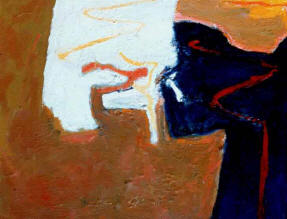 Mount Tamalpais II, 1950. Mount Tamalpais II, 1950.
Oil on Canvas, approx. 36 x 48 in.
Then,
perhaps a month or two later came 1950 Mount Tamalpais II which
was repainted a year later as 1951, In the Big Sur in memory of
Jean's and my and infant Demian's camping trip to Big Sur in the
summer of 1951. (Click here for information about that.)
|
|
 Flowers for the Grave of a Dead Dog, 1951. Flowers for the Grave of a Dead Dog, 1951.
Pastel on paper, 25 x 19 in.
Click here for more information about this painting
This Flowers for
the Grave of a Dead Dog is the only
other surviving pastel from the early 1950's. During the first year
we lived on College Avenue, we got a dog and a cat. The cat we called
Anaximander after the pre-Socratic Greek philosopher, and the dog was
Aphrodite. We had the dog hardly a few months when she ran into the
street and was killed. I made this for her.
I entered the painting
in the Richmond Art Center Annual that year and was accepted. Erle
Loran saw the painting there and afterward complimented me for it. I
had been accepted both at Richmond and by the Berkeley Academy.
I was proud.
*
There were two other
pastels I made then. A young man of my age had been arrested for
raping and murdering a young girl. They caught him when they
found her panties in the dark, dirt basement of the house where he
lived with his parents. His picture was in the paper, gaunt,
tormented, guilt beyond guilt for sexual crime. A friend of mine
said he had known the rapist/murderer when they were in school
together. I looked at the picture in the paper, and, as in every
work of art that moves me, saw myself.
First, I made a pastel
of his face with the city behind. I made in on brown wrapping
paper (we had a lot of it on hand); fixed it--and discovered that
fixing soft pastels on a dark ground destroys them, especially if you
use Krylon Gloss. Then, I tried it again, this time intending to
enter the painting in the upcoming Annual Exhibition of Drawing,
Prints and Watercolors at the SFMOMA, and so including only the
city--avoid the terrible truth of my own cursed face in a work
intended for public display.
The painting was
rejected and I determined never to enter another juried show until I
could be absolutely certain of the power of my work in the face of
every obstacle.
*
By the spring of 1952, my artistic efforts went
into writing, urged by a course in expository writing I was taking in
order to get my teaching credential and a job. Out of that came
my 1951-2 Stories. Click here for the stories.
|
|
Click here for 1953-54
Abstract and Figure Paintings. |
| |
|
|
|
|